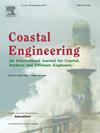浅水区瓦砾堆结构的波浪倾覆排水量
IF 4.2
2区 工程技术
Q1 ENGINEERING, CIVIL
引用次数: 0
摘要
利用浅水区碎石堆防波堤的物理模型试验,研究了沿岸结构的波浪倾覆。确定了三种不同前滩坡度和各种水动力条件下的平均倾覆排水量。水动力结果证实,在极浅的水域中,能量被转移到低频波上,并且在极浅的水域中,短波与低频波同相。因此,由于低频波的能量会影响波浪的倾覆,极端波浪(如 2% 的超高波浪)在极浅水区会变得相对较大。为了估算低频波的能量,推导出了一个合理准确预测低频波能量的表达式(均方误差为 0.06)。考虑到非维度倾覆排水量,现有的非维度平均波浪倾覆排水量公式在浅水区的合理性表现较差,均方根误差介于 1.04 到 2.92 之间。参数敏感性研究表明,短波陡度、相对波峰高度和低频波高是预测浅水区平均翻波排水量的最重要参数。将短波陡度和相对波峰高度纳入经验公式时,当前数据集的 RMSLE 值降至 0.69。如果将低频波高和 2% 超限波高包括在内,则精度会进一步提高(RMSLE 为 0.64)。本文章由计算机程序翻译,如有差异,请以英文原文为准。
Wave overtopping discharges at rubble mound structures in shallow water
Wave overtopping of coastal structures has been studied using physical model experiments with rubble mound breakwaters in shallow water. The mean overtopping discharge is determined for three different foreshore slopes and various hydrodynamic conditions. The hydrodynamic results confirm that energy is transferred to low-frequency waves in very shallow water and that the short waves are in phase with the lower-frequency waves in very shallow water. As a result, the extreme waves (e.g. 2% exceedance wave height) become relatively large in very shallow water due to the energy of the low-frequency waves affecting thereby the wave overtopping. To estimate the amount of energy at the low-frequency waves, an expression is derived which reasonably accurately predicts the low-frequency wave energy (RMSE of 0.06). Considering the non-dimensional overtopping discharge, the existing formulations for the non-dimensional mean wave overtopping discharge perform poorly to reasonably in shallow water with RMSLE ranging from 1.04 to 2.92. A parameter sensitivity study shows that the short-wave steepness, relative crest height and the low-frequency wave height are the most important parameters when predicting the mean overtopping discharge in shallow water. When including the short-wave steepness and relative crest height in an empirical formulation the RMSLE for the current dataset reduces to 0.69. A further increase in accuracy is found when the low-frequency wave height and 2% exceedance wave height are included (RMSLE 0.64).
求助全文
通过发布文献求助,成功后即可免费获取论文全文。
去求助
来源期刊

Coastal Engineering
工程技术-工程:大洋
CiteScore
9.20
自引率
13.60%
发文量
0
审稿时长
3.5 months
期刊介绍:
Coastal Engineering is an international medium for coastal engineers and scientists. Combining practical applications with modern technological and scientific approaches, such as mathematical and numerical modelling, laboratory and field observations and experiments, it publishes fundamental studies as well as case studies on the following aspects of coastal, harbour and offshore engineering: waves, currents and sediment transport; coastal, estuarine and offshore morphology; technical and functional design of coastal and harbour structures; morphological and environmental impact of coastal, harbour and offshore structures.
 求助内容:
求助内容: 应助结果提醒方式:
应助结果提醒方式:


